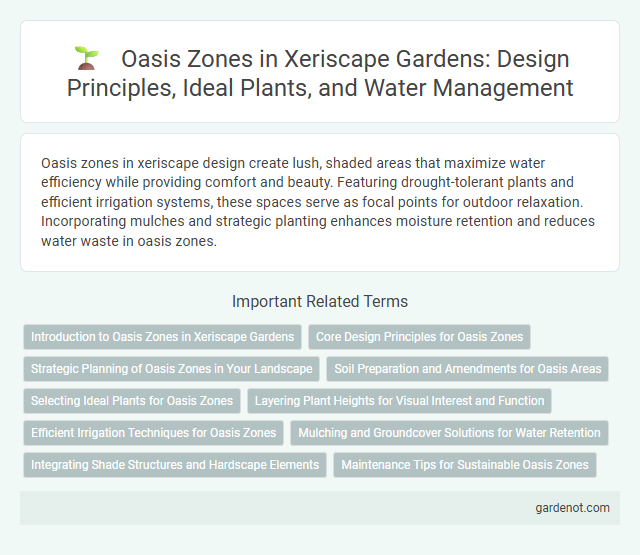Oasis zones in xeriscape design create lush, shaded areas that maximize water efficiency while providing comfort and beauty. Featuring drought-tolerant plants and efficient irrigation systems, these spaces serve as focal points for outdoor relaxation. Incorporating mulches and strategic planting enhances moisture retention and reduces water waste in oasis zones.
Introduction to Oasis Zones in Xeriscape Gardens
Oasis zones in xeriscape gardens serve as lush, sheltered areas designed to create microclimates that support a diverse range of drought-tolerant plants. These zones typically incorporate shade structures, water features, and strategically placed vegetation to reduce evaporation and enhance moisture retention. Integrating oasis zones helps maximize water efficiency while providing comfortable, attractive spaces within xeriscaped landscapes.
Core Design Principles for Oasis Zones
Oasis zones in xeriscaping prioritize water efficiency by incorporating drought-tolerant plants that thrive with minimal irrigation. Strategic soil amendments and mulching enhance moisture retention while reducing evaporation rates significantly. Thoughtful placement of shade trees and windbreaks creates microclimates that lower water demand and improve plant health within oasis environments.
Strategic Planning of Oasis Zones in Your Landscape
Strategic planning of oasis zones in your xeriscape landscape enhances water efficiency by grouping high-water-use plants in localized, well-designed areas. Prioritize soil amendments, microclimate assessment, and irrigation methods like drip systems to sustain these zones with minimal water waste. Integrating oasis zones with drought-tolerant surroundings creates focal points while preserving overall landscape resilience.
Soil Preparation and Amendments for Oasis Areas
Soil preparation in oasis zones prioritizes enhancing water retention and nutrient availability to support drought-tolerant plants characteristic of xeriscape landscaping. Incorporating organic matter such as compost or aged manure improves soil structure, increases moisture-holding capacity, and promotes beneficial microbial activity in arid environments. Adding amendments like gypsum can alleviate soil compaction and salinity issues common in oasis areas, ensuring optimal root development and plant health.
Selecting Ideal Plants for Oasis Zones
Choosing ideal plants for oasis zones in xeriscape involves selecting drought-tolerant species that thrive in partial shade and retain moisture efficiently. Succulents like agave and aloe, along with native trees such as mesquite and palo verde, create a balanced microhabitat with minimal irrigation needs. Incorporating deep-rooted shrubs and perennial herbs enhances soil stability while maximizing water conservation in oasis landscapes.
Layering Plant Heights for Visual Interest and Function
In xeriscape design, layering plant heights in the Oasis zone enhances both visual interest and functional benefits by combining low ground covers, medium shrubs, and taller trees to create depth and texture. This strategic arrangement helps conserve water by creating microclimates that reduce evaporation and encourages biodiversity by providing various habitats. Proper layering also improves soil retention and shade, contributing to a sustainable and aesthetically pleasing landscape.
Efficient Irrigation Techniques for Oasis Zones
Efficient irrigation techniques in oasis zones emphasize drip irrigation systems that deliver precise water amounts directly to plant roots, minimizing evaporation and runoff. Soil moisture sensors integrated with automated irrigation controllers optimize watering schedules based on real-time data, significantly reducing water wastage. Implementing mulch layers and drought-tolerant native plants further enhances water retention and sustainability in these arid environments.
Mulching and Groundcover Solutions for Water Retention
Mulching and groundcover solutions in xeriscape oasis zones play a critical role in enhancing soil moisture retention and reducing evaporation. Organic mulches such as bark, compost, or straw act as insulating layers, while drought-tolerant groundcovers like creeping thyme and sedum create a dense canopy that minimizes water loss. These techniques improve water efficiency, promote healthy root systems, and support sustainable landscaping in arid environments.
Integrating Shade Structures and Hardscape Elements
In xeriscape design, integrating shade structures such as pergolas or arbors with hardscape elements like flagstone patios or decomposed granite pathways enhances outdoor comfort while conserving water. These features create cool, shaded zones that reduce soil evaporation and provide functional living spaces. The strategic placement of shade combined with durable, permeable hardscapes supports sustainable gardening and efficient water use in arid environments.
Maintenance Tips for Sustainable Oasis Zones
Effective maintenance of oasis zones centers on regular pruning of drought-tolerant plants to promote healthy growth and prevent overcrowding. Mulching with organic materials conserves soil moisture while suppressing weeds, reducing the need for excessive watering and chemical herbicides. Scheduling irrigation during early mornings minimizes evaporation, ensuring efficient water use in sustaining the xeriscape oasis ecosystem.
Oasis zone Infographic

 gardenot.com
gardenot.com